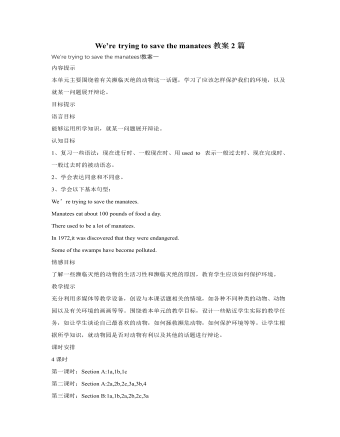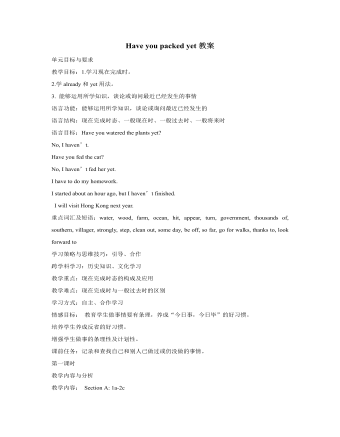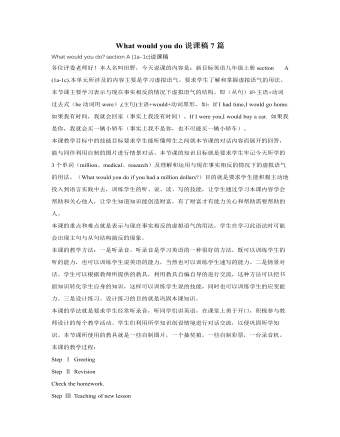热门搜索
人教版新目标初中英语九年级下册You’re supposed to shake hands说课稿7篇文档

人教版新目标初中英语九年级下册You’re supposed to shake hands说课稿7篇
二 、教材分析本单元主要是通过对一些国家的风俗习惯、礼仪差异、时间观念和饮食文化的学习,进一步提高学生对文明生活的认识;加深学生对中外文化的了解,拓展学生的文化视野,为学生阅读相关方面的文章奠定一定的文化基础。我们知道近几年来有关风俗文化,生活习惯的 阅读内容一直是中考热门的话题之一。通过本单元的学习,学生可以掌握一定的相关方面的知识,为今后在阅读积累必要的信息。在Section A 当中出现的 be supposed to 句型为重点句型,此句型的语法结构为被动语态。被动语态也是历年来中考基础命题必考的内容之一。比如,去年的中考试题,在基础选择部分试题中就出现了对此语法结构考查。Section A 首先通过一些图片和句型来让学生初步了解本单元的语言目标。然后,通过练习进一步加以巩固。接着通过一组听力练习,来训练学生的听力,同时,学生可以具体了解到不同的国家在风俗习惯等方面有着怎样的不同。为下面的学习进行铺垫,同时激发学生了解更多的相关知识的学习兴趣。
- 下载

人教版新目标初中英语九年级下册You’re supposed to shake hands教案
教学目标:1. 掌握本单元一些重点词汇的写法和用法。2. 学会自如谈论餐桌礼仪。Step 1 RevisionAsk some students to retell the customs at the table in France in the passage in 3a.Step 2 Self checkPart 1. Fill in each bland with the correct word given. Students do the exercises by themselves at first. Then check the answers. Ask the students to comprehend the sentences and help them point out uses of some words, like “arrive (at / in) sw., spend time / money on sth , spend time / money (in) doing sth.”Part 2. Read about Fan Ling’s experience in a western restaurant. Understand the passage. Point out some key points in the passage.1. be / get used to doing sth. 习惯做某事2. begin with = start with 以….开头3. crowd v. 挤满,塞满 the crowd 人群 crowded adj. 拥挤的Then students discuss about how she would solve her problem. Ask some to share their stories with others.Part 3. Complete the crossword by looking at the sentences on the left. Then check the answers.
- 下载

人教版新目标初中英语九年级下册We’re trying to save the manatees说课稿5篇
教材分析本单元是九年级的最后一个教学新课的单元。这个单元主要是围绕着有关濒临灭绝的动物这一话题,让学生学习怎样保护我们的环境,以及就某一问题展开辩论。在学习新知识的同时,还复习一般现在时(Present Simple)、现在进行时( Present Progress)、一般过去时( Past Tense)、现在完成时(Present Perfect)等时态及被动语态(Passive Voice)。本课为第一课时,是培养听说能力为主的新授课。这节课要为整个单元的学习起到一个热身的作用,不仅要求学生掌握一定的词汇量,为下面的学习打下很好的基础,而且要求学生收集有关濒临灭绝的动物的信息,为后面的话题提供了充分的语言基础和语言依据。因此,我把本课的重点、难点确定于:1、语音、词汇方面:一些表示动物名称的名词(nouns)和描写动物特征的形容词(description words);2、通过听说等练习,让学生运用描述动物的形容词来描述所看到及所知道的动物的特征,同时也复习一般现在时表示主语具备的性格、特征的用法。
- 下载

人教版新目标初中英语九年级下册Have you packed yet说课稿7篇
二 说学情 “以学生的发展为本”的新课程理念,要求教学必须以学生的学习基础、学生需要、学习兴趣等为出发点,联系学生的现代校内外生活,让课堂教学成为学生生命成长和个性张扬的过程。要实现以“学生为本”的理念,教学中必须要做到充分地预设学情。初三学生已经具备了一定的语言基础及语言表达能力,大部分学生对英语还有着比较浓厚的兴趣。同时,在长期的新课程理念熏陶及实践中,已经初步具备了自主,合作,探究的能力。本课教学内容与学生的实际生活密切相关,易于引发学生运用简单的英语进行交际和交流。通过八年级下册第九单元“Have you ever been to an amusement park?”的学习,学生已初步了解现在完成时的基本特征和结构,也比较熟悉“has/have been to…”的句型,这非常有利于本单元教学活动的开展。在此基础上,本单元以“Preparing for a vacation”和“Favorite band”等贴近学生实际生活的内容为话题,继续学习带有already与yet的现在完成时态,较快地激发学生的学习积极性,达成本单元的教学目标。
- 下载

人教版新目标初中英语九年级下册We’re trying to save the manatees教案2篇
本单元主要围绕着有关濒临灭绝的动物这一话题,学习了应该怎样保护我们的环境,以及就某一问题展开辩论。目标提示语言目标能够运用所学知识,就某一问题展开辩论。认知目标1、复习一些语法:现在进行时、一般现在时、用used to 表示一般过去时、现在完成时、一般过去时的被动语态。2、学会表达同意和不同意。3、学会以下基本句型:We’re trying to save the manatees.Manatees eat about 100 pounds of food a day.There used to be a lot of manatees.In 1972,it was discovered that they were endangered.Some of the swamps have become polluted.情感目标了解一些濒临灭绝的动物的生活习性和濒临灭绝的原因,教育学生应该如何保护环境。教学提示充分利用多媒体等教学设备,创设与本课话题相关的情境,如各种不同种类的动物、动物园以及有关环境的画画等等。围绕着本单元的教学目标,设计一些贴近学生实际的教学任务,如让学生谈论自己最喜欢的动物,如何拯救濒危动物,如何保护环境等等。让学生根据所学知识,就动物园是否对动物有利以及其他的话题进行辩论。
- 下载

人教版新目标初中英语九年级下册Have you packed yet教案
教学目标:1.学习现在完成时。2.学already和yet用法。3. 能够运用所学知识,谈论或询问最近已经发生的事情语言功能:能够运用所学知识,谈论或询问最近已经发生的语言结构:现在完成时态、一般现在时、一般过去时、一般将来时语言目标:Have you watered the plants yet?No, I haven’t.Have you fed the cat?No, I haven’t fed her yet.I have to do my homework. I started about an hour ago, but I haven’t finished. I will visit Hong Kong next year.重点词汇及短语:water, wood, farm, ocean, hit, appear, turn, government, thousands of, southern, villager, strongly, step, clean out, some day, be off, so far, go for walks, thanks to, look forward to学习策略与思维技巧:引导、合作跨学科学习:历史知识、文化学习教学重点:现在完成时态的构成及应用教学难点:现在完成时与一般过去时的区别 学习方式:自主、合作学习 情感目标: 教育学生做事情要有条理,养成“今日事,今日毕”的好习惯。培养学生养成反省的好习惯。增强学生做事的条理性及计划性。课前任务:记录和查找自己和别人已做过或仍没做的事情。
- 下载

人教版新目标初中英语九年级下册When was it invented说课稿7篇
《新目标英语》中的具体语言目标是通过各种各样的Tasks来实现的;学生需要运用具体而特定的行动来完成一定的交际任务。整个教学过程中,各种语言结构与语言功能与不同的学习任务有机的结合。任务活动所谋求的效果不是一种机械的语言训练,而是侧重在执行任务中学生自我完成任务的能力和策略的培养;重视形式在完成任务过程中的参与和在交流活动中所获得的经验。因此本节课我将始终引导学生通过完成具体的任务活动来学习语言,让学生为了特定的学习目的去实施特定的语言行动,通过完成特定的交际任务来获得和积累相应的学习经验,让学生在用中学,在学中用。 2、教学原则 l 活动性原则 提倡学生主动参与,体验,交流,合作,探究等多种学习。 l 合作性原则 以学生为主体,师生合作,生生合作,体现教与学的互动,交往。 l 任务型原则 任务驱动—激发动机;任务完成—激励学习积极性;执行任务—培养责任 心和合作精神。 l 情感性原则 激发学生学习英语的兴趣和始终保持良好的学习情绪。
- 下载

人教版新目标初中英语九年级下册I’ll help clean up the city parks说课稿5篇
二、教法学法1、任务型教学法:每个教学环节都是围绕着如何完成一个教学任务来设计的。2、感悟法:创设语境,让学生在一定的语言环境中感悟语言内涵,从而实现悟中学的目的。只有学生自己悟出的东西才能较好地内化为自己的东西。3、合作点拨法:通过教师创设的学习氛围,设置问题和反思质疑,推动师生,生生间的合作探究,小组合作学习,在解决问题中完成教学目标。以培养他们的合作探究的意识与精神。三、教学程序1 导入新课利用课件中的图片导入:在大屏幕上出示汶川大地震中一些悲惨的图片,让同学们说出汶川,然后老师说as well-know a stong earthquake happened in wenchuan,so many kind people go there to help others.再出示一些军人,医疗工作者,志愿者忙碌的身影,特别是温家宝总理看望受伤的孩子,让同学们知道一方有难,四方支持,帮助困难中的人是很有意义的。然后说Would you like to help others?What would you like to do?
- 下载

人教版新目标初中英语九年级下册Rainy days make me sad说课稿6篇
Today I’m very pleased to have an opportunity to talk about some of my teaching ideas. My topic is Section A (1a-1c , Grammar Focus) in Unit13 . It is made up of seven parts.1. Analysis textbook(教材分析)2. The teaching methods(教学方法)3. The learning methods(说学法)4. Analysis the students(说学情)5. The procedures of the teaching(教学步骤)6. Blackboard design(板书设计)7. Self evaluation.(自评)Part 1 The analysis of the teaching material:This lesson is about listening and speaking. It plays a very important part in the English teaching of this unit. By studying Section A , The students can improve their speaking ability, learn more about things that affect people. At the same time, we should get the students to understand better. The students should do some listening, speaking and writing, too. Of course, the students should receive some moral education. Let the students have positive attitude to dealing with things around them.1. Teaching objectsThe teaching aims are established according to Junior School English curriculum standard provision.A.Language goals 1). Words & expressions :tense, some adjectives of feeling 2). Key sentences Loud music makes me tense. (P103)Loud music makes me want to dance.That movie made me sad.B.Ability goals Enable the students to talk about how things affect them.Emotion & attitude goals Enable the students to understand the effect of things upon them.
- 下载

人教版新目标初中英语九年级上册I used to be afraid of the dark说课稿4篇
2、说说写写通过读写训练,进一步学会用 used to 结构来表达自己和同伴过去害怕,或现在仍旧害怕的事情,并且要把最后的结果书写下来,然后让他们将结果用英语告之其他同学,为学生创造展示才能的机会。这样能使全体同学都积极参与,集中精力认真听。既巩固了本节课的目标语言,又为下一个环节3b的对话打下基础。活动结问题比较容易,英语基础较差的学生也能够独立完成,因此,在检查答案是尽量让这部分学生回答,使他们体验到成功后的喜悦,提高他们学习英语的兴趣。 3.对话练习:让学生两人一组,模仿3a中的对话,根据提供的信息与提示词进行对话练习,目的在于对新学的目标语言进行口头练习与设定情景中的运用。为学生创造展示才能的机会。推荐两至三组的同学到教室前面,就所编的对话进行角色表演。
- 下载

人教版新目标初中英语九年级上册Teenagers should be allowed to choose their own clothes说课稿6篇
二、教材分析本课时主要是以听和说的方式来谈论一些家庭和学校的“规矩和制度”,知道那些时可以做的,那些是不可以做的,让学生先从口头上了解这些规矩和制度,为后面的学习做好准备。三、教学的目的和要求1. 掌握短语be strict with sb.的用法,并介绍be strict in sth.的用法;2. 学生能够根据所学的知识,了解用什么方式/句型来制定规章制度。3. 多听,提高学生的习愿望,敦促学生开口说英语,用本课所学的知识来表达自己的意见。四、教学重点和难点1. 如何正确使用be allowed to do…这一句型(在不同时态中的被动语态运用)。2. 如何获得听力技巧及口语技能的提高。五、教学过程T—teacher S—studentS s—students Bb—blackboardStep 1 Warming up Check their homework first, and see if the Ss can make sentences by using the rules in 4, Section A. If possible, try to give some help.
- 下载

人教版新目标初中英语九年级上册It must belong to Carla说课稿5篇
二、教学目标: 1. 知识目标:要求学生掌握使用表示猜测的情态动词。2. 能力目标:让学生做课堂的主人,同时培养他们掌握一些行之有效的学习方法,优化学习效果。3. 情感目标:让学生爱上英语课堂活动,鼓励他们在课堂上进行合作交流。4.学习策略目标:设法使学生掌握使用英语进行交流,学习积极参与班级活动.三、教学分析:1. 说教法:1)任务型教学法:给学生三项任务, 让学生使用这些情态动词来完成这些任务。使他们在任务中学习英语。2)情景教学法:创造足够的交际环境刺激学生的视听能力,使他们能够更好的理解这些情态动词。以培养他们的听和会话能力。3)交易际教学法:学生可以通过俩俩对话或小组对话来掌握这些情态动词。2. 说学法:1)学生要善于把握机会,用英语进行沟通,大胆实践。
- 下载

人教版新目标初中英语九年级上册I like music that I can dance to说课稿8篇
2、 难点结合功能句进行听力练习。确定目标的根据新课程标准规定,通过听、说、读、写的训练,使学生获得英语基础知识和初步运用英语进行交际的能力,激发学生的学习兴趣,为进一步的学习打基础。此外,根据我国国情及新课程标准的要求,现阶段英语教学的素质主要包括思想素质教育,潜在英语能力的培养,非智力因素的培养等几个方面。而我们班的学生本身英语基础不太好,部分学生已经对英语失去了信心,还有一部分学生觉得英语越来越难,渐渐力不从心了,不感兴趣了,上课注意力也不集中了。针对这种情况,备课时要增加趣味性,以此来提高学生对英语的学习兴趣。二、教法学法1、 教法:采取“任务型”教学法。教师根据本节课内容,安排合适的任务,让学生在完成任务的过程中达到本节课所拟定的目标。
- 下载

人教版新目标初中英语九年级上册What would you do说课稿7篇
Get students to complete the activity in groups of four. As the groups work together, move around the room to make sure students discuss the topic in English and know how to fill in the chart.Check the answers by asking different pairs of students to say their conversations to the class.Answers will vary.Optional activityAsk, What would you do if there were no classes tomorrow? Ask students to write as many answers as they can. Then get students to work in pairs. One ask the other the question and see how many new answers the other is able to think of.Step Ⅴ SummarySay, In this class, we've done a lot of reading, speaking and writing practice using the target language.Step Ⅵ Homework(1) Review the target language by reading the conversations in Activity 3a.(2) Finish off the exercises on pages 11~12 of the workbook.Step Ⅶ Blackboard DesignWhat would you do?Section AThe Third PeriodTarget language:A: I can't sleep the night before an exam. Then I'm too tired to do well. What should I do?B: If I were you, I'd take a long walk before going to bed. That should help you relax.A: I really want a dog, but my parents won't let me have one.B: Well, dogs can be a lot of trouble. Maybe you should get a small pet, like a goldfish.A: That's a good idea.
- 下载

人教版新目标初中英语九年级下册When was it invented教案
二、教学 1a,1b.1.First the teacher asks the students what kind of fruit food and drink you like the best and writes down on the blackboard.教师问学生最喜欢什么水果和饮料并把它们写在黑板上。比如:potato chips,ice cream,tea,lemon,chocolate,oranges,salad,popcorn,pickle and so on.2.接着叫学生表达以上食物的味道,引出新单词——sweet,crispy,salty,sour,delicious,hot,awful,nice…并且完成lb教学内容通过此活动,以旧带新引入新单词。其目的是让学生自主学习新知识。 三、教学 2a,2b1.首先,听力前的brainstormFirst,Let students describe how potato chips taste and describe how helpful the potato chips.Then,ask:When and where were potato chips invented?Who were potato chips invented by?How were potato chips invented?(Let students guess according to the following key words.)Key words:by accident,customer,restaurant,by mistake.(说明:通过问题让学生对对话内容有整体了解,为听力练习做好准备;又培养学生的注意力,想像力,观察力。)
- 下载

人教版新目标初中英语九年级上册How do you study for a test说课稿8篇
教学反思:这是学生升入初三的第一节课,学生学习热情很高,通过这一课时的学习,学生掌握了语言目标中所要求的知识重点、难点和语言技能,如by dong, practicing doing ,too……to,现在完成时态,动名词短语做主语及提建议的几种方式,但是有部分学生由于基础较差,还需要从培养学生学习兴趣入手,真正实现教育面向全体学生。在教学中采取的具体办法由:个别辅导,互助学习,留不同层次夫人作业,争取让每一位学生都吃饱而不掉队。How do you study for a test?Two periodsSection BGoals●To listen about learning English●To talk about learning English●To read about learning EnglishProceduresWarming up by reading to the recordingHello, everyone. To begin with, let’s listen and read to the recording of the text HOW DO YOU LEARN BEST? That is, read aloud to the tape, as fast as the tape goes, as clearly as the native reader reads. OK? Here we go!My cat speaks English. Sometimes my cat comes to me and tells me that she is hungry. Or that her leg hurts. How does my cat tell me these things? I don't speak pussy-cat language.1a Reading and checkingLearning English can be both easy and difficult. What things are easy for you? And what things are difficult for you? Now turn to page 5, read the list on the top and check √the statements that are true for you.1b Making a listYou have read and checked the statements true for you. Now think and make a list of other things difficult for you, too.
- 下载

人教版新目标初中英语九年级上册Where would you like to visit教案2篇
The First PeriodⅠ.Teaching Aims and DemandsKnowledge Objects(1) Key Vocabularytiring, educational, fascinating, thrilling, peaceful, exotic, trek, jungle, take it easy, explore, historic, site(2) Target LanguageWhere would you like to go on vacation?I’d like to trek through the jungle, because I like exciting vacations.2. Ability Objects(1)Train students to talk about places they would like to visit with the target language.(2)Train students to describe vacations with different adjectives.(3)Train students' listening skill.3. Moral Object,It′s more interesting to go on vacating somewhere instead of staying at home.Ⅱ. Teaching Key Points1. Key Vocabularytiring, educational, fascinating, thrilling, peaceful, exotic, trek, jungle, take it easy, explore, historic, site2. Target LanguageTalk about different places with the target language.Ⅲ. Teaching Difficult Points1. Describe vacations with different adjectives.2. Talk about different places with the target language.Ⅳ. Teaching Methods1. Teaching by illumination2. Teaching by doing chain drills3. Teaching by pairworkⅤ. Teaching Aids1. A tape recorder2. Some pictures of different places with famous views
- 下载

人教版新目标初中英语八年级下册Have you ever been to an amusement park说课稿7篇
1. 教材的地位及作用:本单元围绕谈论过去的经历,学习使用现在完成时态。通过对学生们喜闻乐见的一些娱乐场所(fun places)的描述,反复运用句型Have you ever been to…? I’ve never been to…. 来激发他们使用本单元所学单词的兴趣。教材中提供的所有活动都以现在完成时态为中心,通过一系列的听、说、读、写的训练,来加深对现在完成时态的理解,明白英汉两种在结构及表达方法的一些异同点。从而提高他们运用所学语言的综合能力。2. 教材的结构本单元分Section A 和Section B 两部分。Section A 中通过所设计的各项任务呈现了两篇听力课文和一篇阅读理解。Section B则安排了一篇听力和两篇小短文,用以加强对目标语言的理解。Self Check 部分是用来检查学生对本单元所学目标语言的综合运用能力。单元后的语篇训练旨在通过目标语言培养学生的阅读理解能力,掌握一些基本的阅读技巧。3. 教学目标(知识目标、能力目标、情感目标)
- 下载

人教版新目标初中英语八年级下册If you go to the party, you’ll have a great time说课稿9篇
二、说教学目标:由于本单元的五个话题都涉及到了不同的条件下所产生的各种结果。所以我确定的本课时的教学目标是:通过谈论图片和身边常见的话题,学会if引导的条件状语从句的用法。即用if条件状语从句作出假设,用will来谈论结果。三、说教学重点:一方面,由于本单元的话题是谈论结果,那么在不同的情境下其结果也会不一样,所以根据不同的情境来推测并谈论各种结果是个重点。另一方面,因为学生没有一个好的语言氛围,所以我侧重于听力和口语的培养,多创设情境能让学生发挥想象,以此激发他们的学习兴趣,。四、说教学难点学生容易记住主句用一般将来时态,从句用一般现在时态,但在判断主句、从句方面容易混淆,因此,我将正确使用主句从句的时态定为本课时的难点。
- 下载

人教版新目标初中英语九年级下册Could you please tell me where the restrooms are教案
Step Ⅰ RevisionCheck homework. Ask a few students to read the article in 3a.Then ask a few students to read their guides.Step Ⅱ Part 1Look at the words in the box. Ask a student to read them. Make sure the students understand the meaning of the words. You are to fill in the blanks with the words. In some cases, students may need to use another form of the word, for example adjusting for tense or subject/ verb agreement.Ask students to fill in the blanks on their own.Check the answers. Step ⅢPart 2Go through the instructions with the class.Look at the example with the students.Ask students what the answer would be.Ask a student to read the question and answer it.Excuse me, could you tell me where the bank is, please?The bank is across the street from the shopping malt.Get students to complete the work in pairs.Check the answers. Ask a few students to read their questions.Step Ⅳ Just for Fun!Ask all the students to read the conversation. Ask: What is funny about this cartoon? Help students to explain. A Martian is a person from the planet Mars.There is no such thing as Martian food on Earth, and the clerk looks silly because he is trying to think of where there is a Martian restaurant.Invite some pairs of students to present this conversation to the rest of the class.Step Ⅴ Summary and HomeworkIn this class, we’ve done much writing practice using the key vocabulary words and the target language presented in this unit. After class, please finish the questions in 2 in your exercise books. Then finish the exercises on pages 47~48 of the workbook as well.The Seventh Period Ⅰ Teaching Aims and Demands1. Knowledge Objects(1) Key Vocabularyimage, adventure, jealousy, hero, crime, journey, brave, no longer, show interest in, take it easy, become interested in, plain looks(2)Text:Grown-ups like cartoons, too.2. Ability Objects(1) Fast-reading to get a general idea of the text.(2) Careful-reading to get the detailed information in the text.
- 下载